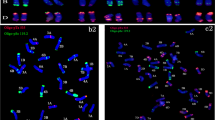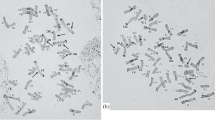Summary
This report deals with a method of analysis which uses existing hexaploid wheat monosomics to establish gene-chromosome associations in a tetraploid variety. Monosomics of Triticum aestivum cv. Chinese Spring belonging to the 14 lines of A and B genomes were crossed as female parents with Triticum durum cv. Capeiti, a spring type at present widely grown in Italy. For each line, two F 1 populations were obtained, normal pentaploids (2 n = 35) and monopentaploid (2 n = 34), in which, in turn, the monosomic A or B chromosome present was supplied by the tetraploid wheat. The morphological and physiological differences observed in the monopentaploid lines are attributed to differential expression of the genetic information concerning the character investigated, carried by the chromosome present in hemizygous condition. Then, only recessive or partially dominant alleles of the variety to be tested can be identified and attributed to a specific chromosome in the F 1 generation.
Eight parameters were analyzed: culm and spike length, length and width of 1st (flag) and 2nd uppermost leaves, days from germination to heading and awn development.
As far as culm length is concerned, although heterotic effect is present, seven chromosomes seem to be responsible for the modification of this character (1A, 2A, 2B, 3B, 4B, 5B, and 6 A); chromosomes 2A and 2B in particular, carry major factor (s) for plant height. A similar picture is presented by spike length which seems to be controlled by factors located in several chromosomes belonging to homoeologous groups 1, 2, 3 and 5, as well as the chromosome 4B.
Leaf length, also, shows a complex pattern of inheritance. Monosomic conditions for chromosomes 1A and 1B increased, while monosomy for 5A and 5B significantly decreased, leaf length. A highly significant correlation was found between the mean lengths of the 1st and 2 nd leaves (= 0.74). Some monosomic lines (4A, 4B, 5A; 5B; 6A; 7A and 7B) had leaves significantly narrower than in the control and only monosomic 2A had broader leaves. The period from germination to heading seems to be influenced by at least 6 chromosomes. Three monosomic lines are significantly earlier (mono 1A, 7A and 5B) and three (mono 5A, 2B and 7B) are significantly later than the hybrid control.
Finally, 8 monosomic lines were found to interfere significantly with awn development. Three lines (mono 2A, 2B and 7A) show a decrease and 5 (mono 1B; 3A, 3B; 4B and 6B) show an increase in awn development. On the basis of evidence in the literature and our own results, it appears that this analysis fits previous results perfectly and actually adds to the picture two further awn-promoting factors, A9 and A10, located on the 7A and 1B chromosomes respectively.
Similar content being viewed by others
Literature
Allan, R. E., Vogel, A. O.: F 1 monosomic analysis involving a smooth-awn durum wheat. Wheat Inform. Serv. 11, 3–4 (1960).
Biffen, R. H.: Studies in the inheritance of disease resistance. J. Agr. Sci. 2, 109 (1907).
Bozzini, A., Giorgi, B., Martini, G.: Aneuploidy induced in tetraploid wheats by means of mutagenic treatments. Proc. Symp. FAO-IAEA, Pullman p. 661–669 (1969).
Camara, A. Y., Mello-Sampayo, T.: Aneuploids on Triticum durum. Genetica Iberica 17, 249 (1965).
Chapman, V., Riley, R.: The allocation of the chromosome of Triticum aestivum to the A and B genomes and the evidence on genome structure. Can. J. Genet. Cytol. 8, 57–63 (1966).
Giorgi, B., Bozzini, A., Carluccio, F.: Analisi cariotipica dei genomi A, B e D in Triticum. Atti Ass. genet. Ital. 12, 426–427 (1967).
Kihara, H., Tsunewaki, K.: Polyploids and aneuploids of Triticum dicoccum var. Khapli produced by N2O-treatment. Wheat Inform. Serv. 14, 1–3 (1962).
Kuspira, J., Millis, L. A.: Cytogenetic analysis of tetraploid wheats using hexaploid wheat aneuploids. Can. J. Genet. Cytol. 9, 79–86; (1967).
Law, C. N., Wolfe, M. S.: Location of genetic factors for mildew resistence and ear emergence time on chromosome 7B of wheat. Can. J. Genet. Cytol. 8, 462–470 (1966).
Longwell, J. H., Sears, E. R.: Nullisomics in tetraploid wheat. Amer. Naturalist 97, 401–403 (1963).
Mochizuki, A.: The monosomics of durum wheat. Proc. of 3rd Intern. Wheat Genetics Symp., Canberra, pp. 310–315 (1968).
Nilsson-Ehle, H.: Kreuzungsuntersuchungen an Hafer und Weizen. Lunds Univ. Arsskr. (N. F.) Afd. 2, Bd. 5, No. 2, 122 p. (1909).
O'Mara, J. G.: The substitution of a specific Secale cereale chromosome for a specific Triticum vulgare chromosome. Genetics 32, 99 to 100 (1947).
Sears, E. R.: Cytogenetic studies with polyploid species of wheat II. Additional chromosome aberrations in Triticum vulgare. Genetics 29, 232–246 (1944).
Sears, E. R.: The aneuploids of common wheat. Missouri Agric. Exp. Sta. Res. Bull. 572, 1–59 (1954).
Strampelli, N.: Alla ricerca e creazione di nuove varietá di frumento a mezzo dell'ibridismo. Conferenza per il Congresso Agrario di Cologno Veneto — Tip. Unione Editrice Roma (1907).
Tsunewaki, K., Jenkins, B. C.: Monosomic and conventional Gene analysis in common wheat. II. Growth habit and awnedness. Jap. Jour. Genet. 36, 428–443 (1961).
Tsunewaki, K.: The transmission of the monosomic condition in wheat variety Chinese Spring. II. A critical analysis of nine year records. Jap. J. Genetics 38, 270–281 (1964).
Unrau, J.: The use of monosomics nullisomics in cytogenetic studies of common wheat. Sci. Agric. 30, 66–89 (1950).
Vavilov, N. J.: The origin, variation, immunity and breeding of cultivated plants, pp. 1–364. — New York: The Ronald Press Co. 1950.
Author information
Authors and Affiliations
Additional information
Communicated by H. Stubbe
Contribution n. 220 from the Laboratorio per le Applicazioni in Agricultura del C. N. E. N., Centro Studi Nucleari della Casaccia, S. Maria di Galeria, Roma, Italy.
With the technical assistance for cytological and statistical analyses of P. Mannino.
Rights and permissions
About this article
Cite this article
Bozzini, A., Giorgi, B. Genetic analysis of tetraploid and hexaploid wheat by utilization of monopentaploid hybrids. Theoret. Appl. Genetics 41, 67–74 (1971). https://doi.org/10.1007/BF00277047
Received:
Issue Date:
DOI: https://doi.org/10.1007/BF00277047




